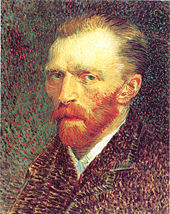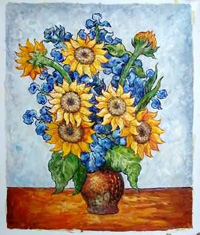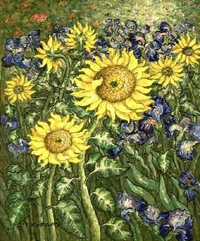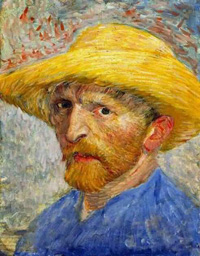Famous Artists
| Paul Cezanne | Salvador Dali | Renoir | Wassily Kandinsky | Joan Miro | Tamara de Lempicka |
| Claude Monet | Gauguin Paul | Picasso | Botero Fernando | Van Gogh | William Bouguereau |
| Vincent Willem van Gogh (30 March 1853 ¨C 29 July 1890) was a Dutch Post-
Impressionist artist. His paintings and drawings include some of the world's
best known, most popular and most expensive pieces. Van Gogh spent his early adult life working for a firm of art dealers. After a brief spell as a teacher, he became a missionary worker in a very poor mining region. He did not embark upon a career as an artist until 1880. Initially, van Gogh worked only with sombre colours, until he encountered Impressionism and Neo-Impressionism in Paris. He incorporated their brighter colours and style of painting into a uniquely recognizable style, which was fully developed during the time he spent at Arles, France. He produced more than 2,000 works, including around 900 paintings and 1,100 drawings and sketches, during the last ten years of his life. Most of his best-known works were produced in the final two years of his life, during which time he cut off part of his left ear following a breakdown in his friendship with Paul Gauguin. After this he suffered recurrent bouts of mental illness, which led to his suicide. The central figure in Van Gogh's life was his brother Theo, who continually and selflessly provided financial support. Their lifelong friendship is documented in numerous letters they exchanged from August 1872 onwards. Van Gogh is a pioneer of what came to be known as Expressionism. He had an enormous influence on 20th century art, especially on the Fauves and German Expressionists. In July 1869, at the age of fifteen, he obtained a position with the art dealer Goupil & Cie in The Hague through his Uncle Vincent ("Cent"), who had built up a good business which became a branch of the firm. After his training, Goupil transferred him to London in June 1873, where he lodged at 87 Hackford Road, Brixton and worked at Messrs. Goupil & Co., 17 Southampton Street. This was a happy time for Van Gogh: he was successful at work, and was already, at the age of 20, earning more than his father. He fell in love with his landlady's daughter, Eug¨Śnie Loyer, but when he finally confessed his feeling to her, she rejected him, saying that she was already secretly engaged to a previous lodger. Vincent became increasingly isolated and fervent about religion. His father and uncle sent him to Paris, where he became resentful at how art was treated as a commodity, and he manifested this to the customers. On 1 April 1876, it was agreed that his employment should be terminated. His religious emotion grew to the point where he felt he had found his true vocation in life, and he returned to England to do unpaid work, first as a supply teacher in a small boarding school overlooking the harbour in Ramsgate; he made some sketches of the view. The proprietor of the school relocated to Isleworth, Middlesex. Vincent decided to walk to the new location. This new position did not work out, and Vincent became a nearby Methodist minister's assistant in wanting to "preach the gospel everywhere." At Christmas that year he returned home, and then worked in a bookshop in Dordrecht for six months, but he was not happy in this new position and spent most of his time in the back of the shop either doodling, or translating passages from the Bible into English, French, and German. His roommate from this time, a young teacher called Gorlitz, later recalled that Vincent ate frugally, preferring to eat no meat. In an effort to support his wish to become a pastor, his family sent him to Amsterdam in May 1877 where he lived with his uncle Jan van Gogh, a rear admiral in the navy. Vincent prepared for university, studying for the theology entrance exam with his uncle Johannes Stricker, a respected theologian who published the first "Life of Jesus" available in the Netherlands. Vincent failed at his studies and had to abandon them. He left uncle Jan's house in July 1878. He then studied, but failed, a three-month course at the Protestant missionary school (Vlaamsche Opleidingsschool) in Laeken, near Brussels. In January 1879 Van Gogh got a temporary post as a missionary in the village of Petit Wasmes in the coal-mining district of Borinage in Belgium, bringing his father's profession to people felt to be the most wretched and hopeless in Europe. Taking Christianity to what he saw as its logical conclusion, Vincent opted to live like those he preached to, sharing their hardships to the extent of sleeping on straw in a small hut at the back of the baker's house where he was billeted; the baker's wife used to hear Vincent sobbing all night in the little hut. His choice of squalid living conditions did not endear him to the appalled church authorities, who dismissed him for "undermining the dignity of the priesthood." After this he walked to Brussels, returned briefly to the Borinage, to the village of Cuesmes, but acquiesced to pressure from his parents to come "home" to Etten. He stayed there until around March the following year, to the increasing concern and frustration of his parents. There was considerable conflict between Vincent and his father, and his father made enquiries about having his son committed to a lunatic asylum at Geel. Vincent fled back to Cuesmes where he lodged with a miner named Charles Decrucq, with whom he stayed until October. He became increasingly interested in the everyday people and scenes around him, which he recorded in drawings. In 1880, Vincent followed the suggestion of his brother Theo and took up art in earnest. In autumn 1880, he went to Brussels, intending to follow Theo's recommendation to study with the prominent Dutch artist Willem Roelofs, who persuaded Van Gogh (despite his aversion to formal schools of art) to attend the Royal Academy of Art. There he not only studied anatomy, but the standard rules of modelling and perspective, all of which, he said, "you have to know just to be able to draw the least thing." Vincent wished to become an artist while in God's service as he stated, "to try to understand the real significance of what the great artists, the serious masters, tell us in their masterpieces, that leads to God; one man wrote or told it in a book; another in a picture." |
Copyright © XIAMEN DOOYI IMP.& EXP.CO.LTD
Address: 3/F NO.33 NAN PIAN, SHI TANG CUN HAI CANG QU, XIAMEN CHINA Postcode: 361026
Tel: 0086-592-6516557 Fax: 0086-592-6516857 MSN: oilpainting0001@gmail.com
Email: oilpainting0001@gmail.com



